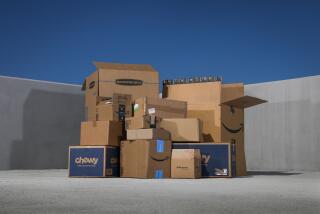THE CUTTING EDGE: COMPUTING / TECHNOLOGY / INNOVATION : Cardboard, the Quicker Picker-Upper
- Share via
When it comes to recycling, tiny Quadratech, located in Inglewood, may be the champ at letting nothing go to waste. The company’s main product line, which is used to clean up oil spills, starts with recycled cardboard. The oil picked up by Quadratech’s absorbent “pillows” can be squeezed out and returned to the refinery. The material itself, which still contains some oil, is then pressed into a fire log which, when burned, leaves less than 1% ash.
The secret to turning recycled cardboard or paper into a quicker picker-upper lies in what Maria Comfort, the company’s president, calls its “magic sauce.” The mixture contains silicon and surfactants that, when mixed with paper, make the paper waterproof. When the paper is thrown into an oil spill, it absorbs the oil but not the water. It is also harmless to fish and birds, Comfort said.
Quadratech has developed a product that absorbs and retrieves spilled oil and gas from oily surfaces such as service stations, machine shops and barge floors. Its customers include the military, Peabody Mines, Texaco and Pacific Gas & Electric. Quadratech has used the same technology to develop Flush-It, a flushable kitty litter made from recycled paper mixed with deodorizers.
*
Fuel-Eating Bacteria: As ballistic missiles such as the Peacekeeper, Minuteman, Patriot, Titan and others have been decommissioned, thousands of tons of fuel have piled up in storage. If the fuel is stored, it eventually becomes unstable, creating a safety hazard. Until now, there has been no good way to dispose of stored fuel. It can no longer be burned in open pits, because burning pollutes the air, and landfill burial is hazardous because of the fuel’s explosive potential and toxicity.
Fungus and bacteria to the rescue. Using a combination of chemicals and biological agents, researchers at USC have come up with a way to break down the polymer binders in rocket fuel, segregate and isolate the explosives and extract the metals and other useful components for possible reuse.
Chemical and physical procedures break up the solid mass of fuel, reducing it to a soft jelly. Treatment with ultrasound and a mild oxidizing chemical sets the stage for extracting the metals. Then the fungus and bacteria break down the fuel’s high-explosive components into methane, ammonia and other harmless substances.
*
Cereal Eye Tests: Eye tests, which were once administered to grade school children, are being used at younger and younger ages. Scientists have discovered that the visual systems of children develop so rapidly that by the age of 6 months, their eyes and vision are very much like that of adults. It is important to catch certain vision problems long before a child reaches school age.
One condition known as amblyopia can lead to permanently poor vision in one eye and a loss of depth perception if uncorrected by age 6. Eye researchers at UC Berkeley are beginning to set up screening programs in Bay Area preschools for children ages 6 months to 3 years.
How do you test children who can’t even speak? The answer is pretty low-tech. Testers use a cereal reward or a happy face to attract the attention of very young children. In the Cheerios test, they pop a Cheerio into the toddler’s mouth every time he points to or looks at a picture of one. By varying the size and distance of the picture, doctors can determine the smallest image the child can distinguish from a square of similar size and color. The Cheerio and happy face tests are now in use nationally on infants and toddlers.
*
Dry-Cleaned Semiconductors: When it comes to the silicon wafers used to make semiconductors, dirt means death. Even the tiniest dust particle can ruin a chip, where the etched circuits are minuscule. Most manufacturers use a wet cleaning process that involves expensive water-deionizing plants and toxic chemicals. But Radiance Services Co. in Bethesda, Md., has come up with a way to use low-powered lasers to dry-clean wafers.
Some researchers have experimented with laser cleaning, using the laser to deliver controlled amounts of heat to break the bonds between the contaminant and the part. The problem with this approach is the danger of also damaging the part itself. Radiance’s process involves scanning a wafer with a low-power, deep-ultraviolet excimer laser while an inert gas flows over the surface.
At low power and at certain wavelengths, photons break the atomic bonds that attach surface particles to a wafer, without damaging the wafer. Two companies, Exitech in Britain and Neumann Microtechnologies in New Hampshire are developing wafer-cleaning systems with the Radiance technology.
More to Read
Inside the business of entertainment
The Wide Shot brings you news, analysis and insights on everything from streaming wars to production — and what it all means for the future.
You may occasionally receive promotional content from the Los Angeles Times.










